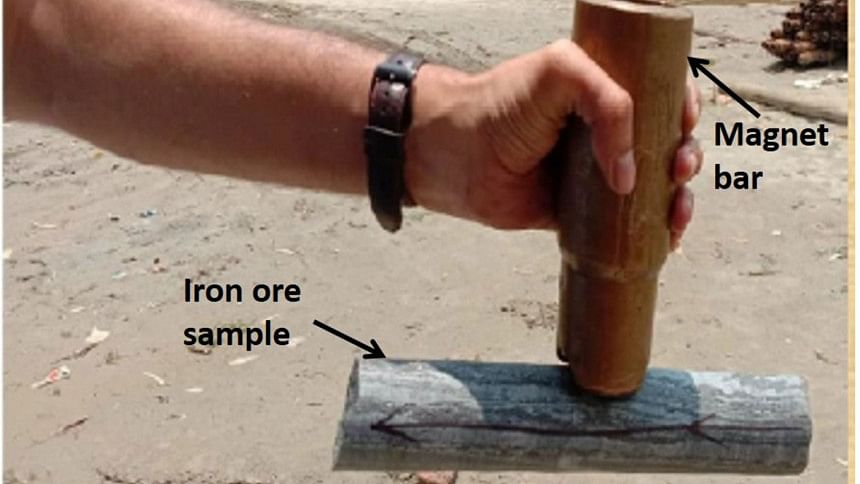Discovery of magnetic iron ore reserve in Dinajpur

He holds a piece of the rock sample and brings it near to a magnet bar. Instantly, the rock sample gets attached to the magnet and hangs on to it when the magnet bar is held up in the air. "This is magnetite ore, a magnetic iron-rich mineral valued worldwide for its content, and we have just discovered a big reserve of this mineral only 450 metres below the surface at Alihat, Hakimpur Upazila, Dinajpur," said Mohammad Masud, a geoscientist working with the Geological Survey of Bangladesh (GSB), a government organisation dedicated to the discovery of natural mineral resources. This was disclosed in a programme last week arranged by the GSB and sponsored by the Ministry of Power, Energy and Mineral Resources aiming at exchange of ideas with national experts and academicians about the discovery.
The rock sample he shows me is small, but the implication of this discovery is far greater, because this may pave the way for opening up iron mine, a new kind of economic mineral resource development in Bangladesh. The mineral magnetite is used as one of the sources of iron, the basic element for the manufacture of steel. And the importance of steel in the infrastructural development of any nation cannot be overemphasised. Bangladesh, in its drive toward infrastructure development including the mega projects, produces about 7 million tons of steel products annually, for which it depends totally on imported material of iron.
The way to discovery
It all began in early 1970s when a foreign geophysical company made an airborne aeromagnetic survey that indicated some magnetic highs beneath Dinajpur-Rangpur districts. Later in 2012, GSB conducted more systematic and targeted gravity and magnetic surveys in the area and found a few magnetic anomalies, meaning areas of high values of magnetic readings. This prompted the geologists of GSB to target specific points to drill and test the presence of magnetic mineral of commercial importance, if any. The first borehole named GDH-68/13 was drilled in 2013 and was successful in locating an iron ore mineral zone at the depth of only 445 metres.
Encouraged by the success, three more wells were drilled in the area between 2013 and 2020 and all three boreholes record the presence of iron ore mineral zones. From the data obtained from the four successful wells, it has been primarily suggested that the iron ore body extends for about 5 to 6 sq km. The depths at which the top of the iron ore zone occurs in these wells range from 406m to 445m. The average thickness of the iron ore zone is estimated at about 50m. A preliminary and approximate reserve estimate suggests that the reserve is very significant and commercially viable.
A rough calculation would suggest that production of a million ton of ore annually (the same level of production capacity in Maddhapara hard rock mine as well as in Barapukuria coal mine) would run the mine for about 100 years. However, the database on which the above estimate is made has been considered inadequate, and there are suggestions that further wells should be drilled to more accurately delimit and define the extent and reserves of the ore body.
The overall magnetic survey results have shown that in addition to the magnetic high at Alihat area, there are positive magnetic anomalies in a few more places of Hakimpur upazila and surrounding areas. This raises hope that a similar iron ore body may be encountered nearby if these areas are tested by drilling. A cluster of iron ore bodies in close proximity would make the economy of mining iron ore more feasible and profitable.
Geological predictions
The magnetite ore samples that were extracted from the discovered borehole are crystalline, dense, heavy and hard with alternating black and white crystalline bands. It is in total contrast to the soft soil of Bangladesh beneath which it hides. This does not puzzle the geologists who are acquainted with the geological predictions made much earlier.
Interestingly, geoscientists' interpretation and predictions often lead to resource discoveries. About 150 years ago, British geologist Robert Mallet, while inaugurating the first Indian coal mine at Raniganj in West Bengal, predicted that coal deposits of a similar kind would one day be found under the plain land of East Bengal. This prediction was proven right when GSB discovered the first coal reserve in Bangladesh plain at Barapukuria, Dinajpur in 1985. In independent Bangladesh in 1980s, renowned geologist Dr F.H. Khan reasoned and named the Dinajpur-Rangpur area as "Dinajpur Shield". He predicted that metallic mineral deposits were likely to be found beneath this area because shield areas are a habitat of metallic deposits as seen in the vast terrains of Orissa-Bihar to the west and other parts of very large Indian Shield. It took a new generation of geologists to prove Dr Khan's prediction right by the Dinajpur discovery in 2020.
In fact, the hard, dense, crystalline rocks found beneath only a few hundred metres in Dinajpur are the oldest rocks in Bangladesh—between 1,000 and over 3,000 million years old. These rocks formed from extremely hot and dense magmatic liquid, cooled and pressurised at the very early years of the Earth's history. These are hard, crystalline igneous and metamorphic rocks as found beneath the Dinajpur-Rangpur area. The remaining part of Bangladesh is made up of much younger and soft sedimentary rocks with the present deltaic Bangladesh only less than three million years old.
A prudent forward move required
There have been reports that a further evaluation of the discovered iron ore in Dinajpur will be handled by a different governmental agency—the Barapukuria coal mine company. But this coal mining company has little to do with mineral or hard rock geology or mining. Furthermore, the Barapukuria coal mine has its own challenge to tackle to continue coal production after the present production ends in the central part of the mine, and with the expiry of the present contract with the Chinese mining company in about a year. On the other hand, Maddhapara Granite Mining Company Limited, also in Dinajpur, is managing the granite hard rock production and is more suited to taking over management of the iron ore body in question. In any case, a foreign consultant is supposed to be engaged for the evaluation and mining feasibility study of the iron deposit.
However, the evaluation of the iron ore reserve by the GSB is not completed. It would be wise to let GSB continue its own evaluation of the discovered iron ore to reach a more mature and complete stage. We should know enough of a resource base before we engage a foreign company to evaluate and mine it. That will give us more power in a negotiating table with a third party. A well-thought-out policy with respect to natural resource exploitation is important to safeguard the national interest, even if it means a slower pace of action. Bangladesh's track record on natural resource exploration and exploitation shows that national interests have been undermined in several cases in the past.
Dr Badrul Imam is Honorary Professor at the Department of Geology, University of Dhaka.

 For all latest news, follow The Daily Star's Google News channel.
For all latest news, follow The Daily Star's Google News channel. 



Comments